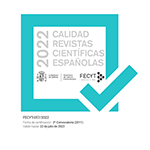The case of the Itata estuary (Bio-Bio Region-Chile) plant formations: anthropogenic interference or natural disturbance-induced diversity enrichment?
Abstract
The current study examined the relationship between native and introduced plant species, as indicators of the state of anthropogenic influence on plant formations in the area of the Itata estuary (Bío-Bío Region, Chile). A total of 186 vegetation samples were collected in different plant communities in the wetlands and adjacent areas of the Itata River during 2011 and 2012. The communities of four terrestrial plant formations were sampled within dunes, prairies, shrub lands and food crops, and within two aquatic habitats (freshwater and salt marsh). The total flora comprised of 222 species, these were dominated by introduced taxa with thirty-three species considered invasive for Chile. The high percentage contribution of these alien weeds to the total community could be interpreted as signs of a strong degree of anthropogenic interference in the natural plant formations. However, some habitats such as salt marshes are subjected to periodic natural disturbances (e.g. tsunamis), lacking human interference. Consequently, in some habitats, alien species, which are more resilient, represent the primary plant formations.
Downloads
Article download
License
Mediterranean Botany is an open access journal to promote global exchange knowledge. It facilitates unrestricted access to its contents from the moment of publication in its electronic edition. The originals published are property of the Universidad Complutense and it is mandatory to cite such source in case of total or partial reproduction. All contents are distributed under a Creative Commons License 4.0 (CC BY 4.0). This circumstance must be expressly stated in this way when necessary. You can check the informative version and legal text of the license.













